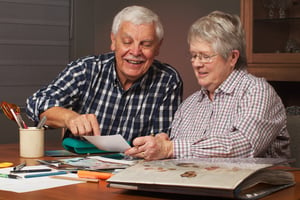There are a number of activities that can be done at home to help you or a loved one adapt to physical challenges.
Occupational therapy frequently is part of a person's rehabilitation as they recover from an injury or health event. The goal of occupational therapy is to help you reach your maximum level of independence as you perform your daily activities which make include eating, dressing, mobility, and so on. There are a number of activities that can be done at home to help you or a loved one adapt to physical challenges. Listed below are seven at-home activities to help you gain strength and mobility.
 1. Stacking Coins
1. Stacking Coins
What you need: Gather a handful of loose change and practice stacking coins on top of each other.
How it helps: This will help improve hand-eye coordination and fine motor skills.
2. Stringing Beads
What you need: Large beads with large holes are easier to work with when you start beading. As you become more skillful, you can transition to smaller beads with smaller holes. You can string large beads onto yarn, pipe cleaners, shoelaces, or ribbons.
How it helps: Stringing beads helps maintain hand-eye coordination and fine motor skills. This activity strengthens hand and finger muscles. Beading is a popular hobby for many who find it relaxing. An added bonus you create accessories such as necklaces, bracelets, key chains and more. Having a finished product, you can wear or share as a gift can be emotionally rewarding.
3. Toss a Ball .jpg?width=227&name=iStock-509732600%20(1).jpg)
What you need: A lightweight ball is best when you begin this activity. You can progress to a heavier ball as you gain strength.
How it helps: This activity can improve your range of motion, sharpen your hand-eye coordination, and strengthen your muscles. This activity is inherently social since it requires at least two people.
4. Squeezing a Ball
What you need: A soft or stress ball.
How it helps: Squeezing a ball also builds muscle in your hand and wrist. Therapists typically recommend people squeeze and release the ball in sets of 10. You may need to gradually build up performing this activity 10 times in a row.
5. Journaling or Memoir Writing
What you need: A pen and paper or a notebook.
How it helps: The physical aspect of writing boosts your fine motor skills. Journaling and memoir writing improve memory and helps organize your thoughts. These activities tend to deepen your sense of emotional well-being.
6. Origami (Paper Folding)
What you need: Although you can purchase traditional origami paper, construction paper or copy paper works well for many origami projects.
How it helps: This activity is a great brain booster. Origami promotes relaxation, concentration, hand-eye coordination, and fine motor skills. During this activity, you follow steps to create a work of art. The outcome of the creative process builds your confidence and self-esteem.
7. Scrapbooking 
What you need: Basic supplies to begin scrapbooking include photos, an album, cardstock, adhesive, patterned paper, scissors, pen, and colored pencils or markers.
How it helps: This activity increases your dexterity, coordination, and finger strength. Scrapbooking can be calming. This activity promotes cognitive health by triggering memories as you work with your photographs. Other benefits include providing a sense of accomplishment, building competence, and practicing organizational skills.
These occupational therapy activities require no specialized equipment and can be done in the convenience of your home. Give these useful activities a try to help support in restoring functionality.
Contact our team at Church Home LifeSpring to schedule a tour of our facility and learn how we can support you or a loved one’s occupational therapy needs. Our commitment is to guide you on your road to recovery and enhanced quality of life.

